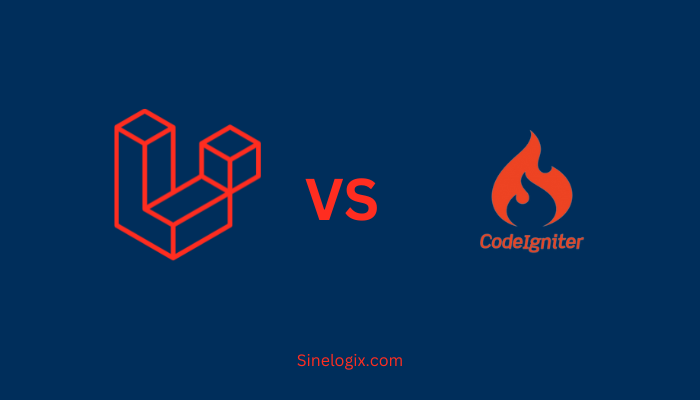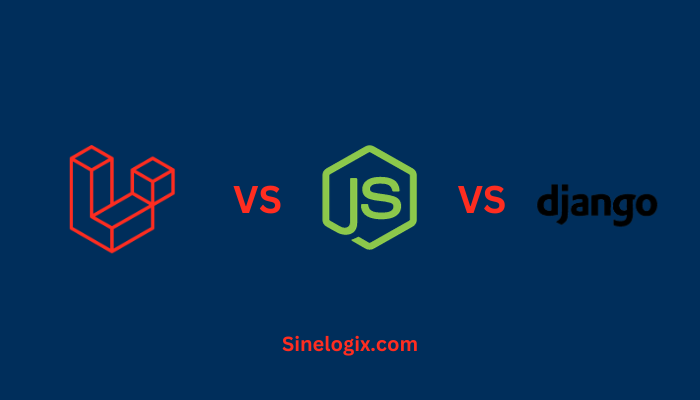In the world of web development, choosing the right PHP framework can make a significant impact on the success of your project.
Laravel and CodeIgniter are two popular choices, each with its own strengths and weaknesses. In this article, we’ll conduct a detailed comparison of Laravel and CodeIgniter, covering various aspects to help you make an informed decision.
Introduction to Laravel and CodeIgniter
Laravel:
Laravel is a modern, open-source PHP framework known for its elegant syntax and robust features. It was created by Taylor Otwell and has gained immense popularity due to its developer-friendly ecosystem and extensive libraries. Laravel follows the Model-View-Controller (MVC) architectural pattern, making it a great choice for building web applications of varying complexities.
CodeIgniter:
CodeIgniter, on the other hand, is a lightweight PHP framework that focuses on simplicity and performance. It has been around for quite some time and has a reputation for being beginner-friendly. CodeIgniter adopts a minimalistic approach, allowing developers to choose their components and configurations, making it a flexible option for a wide range of projects.
Now, let’s dive deeper into the comparison:
1. Ease of Learning and Documentation
Laravel:
Laravel is known for its extensive and well-structured documentation. It comes with a wide range of built-in features that simplify common tasks, making it easier for developers to get started. The vibrant Laravel community also offers various resources, tutorials, and forums for beginners to learn and grow.
CodeIgniter:
CodeIgniter is often lauded for its simplicity and minimal learning curve. Its documentation is comprehensive and straightforward, making it a great choice for developers new to PHP frameworks. The framework’s small footprint allows developers to understand its core components quickly.
2. Performance
Laravel:
Laravel is feature-rich, which can sometimes impact its performance. However, it compensates for this by offering efficient tools for caching, optimization, and database management. With the right configurations and optimizations, Laravel can handle high-traffic applications with ease.
CodeIgniter:
CodeIgniter is designed to be lightweight and fast. It doesn’t have as many built-in features as Laravel, which can contribute to its better performance in scenarios where a small overhead is critical. If you’re developing a lightweight application or an API, CodeIgniter might be a better choice for performance reasons.
3. Architecture and Extensibility
Laravel:
Laravel follows the MVC architecture out of the box, making it an excellent choice for building scalable and maintainable applications. It comes with an extensive ecosystem of packages, and you can easily extend its functionality using Composer. Laravel’s robust Artisan command-line tool simplifies tasks such as migration, seeding, and testing.
CodeIgniter:
CodeIgniter allows developers to be more flexible when it comes to architecture. It does not force a specific pattern on you, which can be an advantage in some cases but might lead to a less structured codebase if not managed properly. It offers the flexibility to choose the components you need, allowing you to create a custom architecture tailored to your project’s requirements.
4. Security
Laravel:
Laravel takes security seriously and includes features like protection against SQL injection, cross-site scripting (XSS) attacks, and cross-site request forgery (CSRF) out of the box. Its authentication and authorization systems are robust and easy to implement, reducing the likelihood of security vulnerabilities.
CodeIgniter:
CodeIgniter also prioritizes security but leaves more of the security responsibility in the hands of the developer due to its minimalistic nature. While this flexibility can be an advantage, it also means that developers must be diligent in implementing security practices.
5. Community and Ecosystem
Laravel:
Laravel has a vibrant and active community, which is one of its biggest strengths. The community provides extensive support, frequent updates, and a wide array of packages and plugins available via Composer, making it easy to extend the framework’s functionality.
CodeIgniter:
CodeIgniter, while not as large as Laravel’s community, has a dedicated following and a repository of libraries and resources. However, it may be more challenging to find CodeIgniter-specific solutions for advanced requirements compared to Laravel.
6. Scalability
Laravel:
Laravel is well-suited for building scalable applications due to its adherence to MVC architecture, built-in tools, and packages for handling database scaling and queue management. With proper architecture and optimization, Laravel can handle the growth of your application.
CodeIgniter:
CodeIgniter can also handle scalability, but it might require more manual intervention, as it offers fewer built-in tools for managing large-scale applications. If you have a straightforward project, scalability may not be a significant concern.
7. Popularity and Industry Adoption
Laravel:
Laravel has gained widespread popularity and is often the framework of choice for startups and large enterprises alike. Its popularity can be attributed to its modern features, excellent documentation, and extensive community support.
CodeIgniter:
CodeIgniter, while less hyped, still enjoys a loyal user base and is used in various projects, especially where a lightweight framework is preferred. Its ease of use and minimalistic approach make it a sensible choice for smaller projects and rapid development.
8. Testing and Quality Assurance
Laravel:
Laravel makes testing a fundamental aspect of development through its integration with PHPUnit. It offers a robust testing environment with built-in support for test-driven development (TDD) and PHPUnit for unit and feature testing. This ensures the codebase’s reliability and maintainability.
CodeIgniter:
CodeIgniter provides basic testing tools but does not have the same level of built-in support as Laravel. Developers need to rely on third-party testing libraries, which may require additional configuration and setup. While testing is possible in CodeIgniter, it may require more manual effort.
9. Database Support
Laravel:
Laravel supports multiple databases, including MySQL, PostgreSQL, SQLite, and SQL Server. It provides an elegant and expressive query builder and an ORM (Object-Relational Mapping) called Eloquent, which simplifies database operations and makes it easier to work with different database systems.
CodeIgniter:
CodeIgniter also supports a variety of databases, making it flexible in terms of database choices. However, it provides a more straightforward, traditional database querying approach compared to Laravel. If you have experience with SQL, CodeIgniter’s database handling may feel more familiar.
10. RESTful API Development
Laravel:
Laravel is well-equipped for building RESTful APIs. It provides tools and features like resource controllers, middleware, and API rate limiting out of the box, making it an excellent choice for developing APIs and microservices.
CodeIgniter:
CodeIgniter can be used to build RESTful APIs, but it requires more manual configuration compared to Laravel. While it lacks some of the built-in features for API development, it is still a viable option if you prefer a more lightweight approach.
11. Community and Long-Term Support
Laravel:
Laravel’s larger community and backing by Taylor Otwell ensure ongoing development and long-term support. It receives frequent updates, security patches, and new features. This makes it a safer bet for projects that require continuous maintenance and evolution.
CodeIgniter:
CodeIgniter is maintained by a smaller team and community. While it has received updates and improvements over the years, the pace of development might be slower compared to Laravel. For projects that have longer lifecycles and need continuous support, this can be a factor to consider.
12. Licensing and Cost
Laravel:
Laravel is open-source and released under the MIT license, making it free for commercial use. You can use it for any project without incurring licensing costs. However, additional tools and services related to Laravel, such as Forge and Envoyer, may come with their pricing.
CodeIgniter:
CodeIgniter is also open-source and released under the MIT license, similar to Laravel. It is free to use in commercial projects without any licensing costs. This makes both frameworks cost-effective choices.
13. Ecosystem and Package Management
Laravel:
Laravel’s ecosystem is rich and thriving. It leverages Composer for package management, which offers a vast repository of third-party packages and libraries. This allows developers to extend Laravel’s functionality with ease, benefiting from a wide range of pre-built solutions.
CodeIgniter:
CodeIgniter has a smaller ecosystem compared to Laravel but still offers packages and libraries through Composer. However, the selection may be more limited, and developers might need to build custom solutions for certain requirements.
14. Global Adoption and Job Market
Laravel:
Due to its widespread popularity, Laravel developers are in high demand in the job market. Laravel-based projects are prevalent, and many companies prefer this framework for their web development needs. This can be advantageous for developers seeking job opportunities.
CodeIgniter:
CodeIgniter has a presence in the job market, especially in projects that have been using it for a while. However, the demand for CodeIgniter developers is generally lower compared to Laravel, which can limit job opportunities.
15. Upgrading and Maintenance
Laravel:
Laravel offers clear guidelines and tools for upgrading between versions. It has a well-documented upgrade process, making it easier to keep your application up to date. The availability of long-term support (LTS) releases ensures stability and ongoing support.
CodeIgniter:
CodeIgniter has a more manual process for upgrading between versions, and it may require more effort and time to ensure compatibility. While maintaining an older CodeIgniter application is possible, upgrading it to the latest version might not be as straightforward.
16. Community Packages and Extensions
Laravel:
Laravel’s community has developed numerous packages and extensions for common use cases, which can significantly speed up development. These range from authentication solutions to e-commerce platforms, giving developers access to a wide range of pre-built functionality.
CodeIgniter:
CodeIgniter’s community also provides extensions and libraries, but the selection may be more limited compared to Laravel. Developers may need to create custom solutions for more specialized requirements.
Related Articles:
Conclusion
In the Laravel vs. CodeIgniter showdown, the choice ultimately depends on your project’s specific requirements. Laravel excels in building complex, feature-rich web applications with a focus on maintainability and code structure. CodeIgniter, on the other hand, is a great choice for smaller, performance-critical projects where simplicity and flexibility are key.
Before making a decision, consider your team’s expertise, the project’s size and complexity, and your long-term goals. Both Laravel and CodeIgniter have their merits, and the right choice will lead to a successful web development journey.




